SAR课程实验报告
INSAR实验报告

实验一、SAR信号统计模型验证实验目的通过MATLAB编程,拟合有关SAR数据的实部、虚部、灰度、相位的概率密度曲线,并与实际曲线进行比较,掌握MATLAB编程的初步知识。
实验数据txt文本格式的实部和虚部数据实验步骤一、打开MATLAB,根据老师给出的实部的MATLAB的程序和拟合曲线,试着编出虚部的程序,调试并运行。
二、在实部实验的基础上,接着进行以后的改编,根据各个曲线的表达式,拟合各自的曲线。
实验结果实部:灰度:相位:实验心得这是首次用MATLAB编程实现SAR的统计特征图像,由于之前没有用MATLAB编程实现过,所以这次实验是在学习老师所给程序的基础上进行改编的。
学会了MATLAB中画图函数的编写,函数曲线的颜色、线型、多幅图像同时呈现编程方法。
但是功率power的图像画的并不理想,拟合的曲线并没有很好地显示出来。
通过这次的练习,平时老师课件里的东西,我们也能编程写出来,确实让我们学会了理论联系实践,学以致用。
这次的实验还比较顺利,希望在以后的学习和实验中可以更多的学习一些软件,多用编程的思想实现一些自己的想法。
实验源代码实部:clear;clc;load 'Real.txt';load 'Imag.txt';[m,n]= size(Real);Realvector=reshape(Real,m*n,1);maxreal=max(Realvector);minreal=min(Realvector);x=minreal:10:maxreal;Realvar=var(Realvector);PDF_Re=exp(-x.^2/(2*Realvar))/sqrt(2*pi*Realvar); pixel_count1=PDF_Re*10*m*n;figure;plot(x,pixel_count1,'r');count2=hist(Realvector,x);hold on;plot(x,count2,'rs','MarkerEdgeColor','k',...'MarkerFaceColor','g',...'MarkerSize',2);ylabel('Pixel count');xlabel('Realistic component(Re)');虚部:clear;clc;load 'Real.txt';load 'Imag.txt';[m,n] = size(Imag);Imagvector=reshape(Imag,m*n,1);maximag=max(Imagvector);minimag=min(Imagvector);x=minimag:10:maximag;Imagvar=var(Imagvector);PDF_Im=exp(-x.^2/(2*Imagvar))/sqrt(2*pi*Imagvar); pixel_count2=PDF_Im*10*m*n;figure;plot(x,pixel_count2,'r');count=hist(Imagvector,x);hold on;plot(x,count,'rs','MarkerEdgeColor','k',...'MarkerFaceColor','g',...'MarkerSize',2);ylabel('Pixel count');xlabel('Imaginary component(Im)');灰度:load 'Real.txt';load 'Imag.txt';[m,n] = size(Imag);Amplitude=sqrt(Real.^2+Imag.^2);Amplitudevector=reshape(Amplitude,m*n,1);Ampvar=var(Amplitudevector)*2/(4-pi);maxAmp=max(Amplitudevector);minAmp=min(Amplitudevector);X=minAmp:10:maxAmp;PDF_A=X.*exp(-X.^2/(2*Ampvar))/Ampvar;pixel_count2=PDF_A*10*m*n;figure;plot(X,pixel_count2,'r');count=hist(Amplitudevector,X);hold on;plot(X,count,'rs','MarkerEdgeColor','k',...'MarkerFaceColor','g',...'MarkerSize',2);ylabel('Pixel count');xlabel('Amplitude component(A)');功率:clear;clc;load 'Real.txt';load 'Imag.txt';Powe=Real.^2+Imag.^2;[m,n] = size(Powe);Powevector=reshape(Powe,m*n,1);maxPowe=max(Powevector);minPowe=min(Powevector);x=minPowe:10000:maxPowe;Powevar=var(Powevector);PDF_P=(exp(-x/(2*Powevar)))/(2*Powevar); pixel_count4=PDF_P*10*m*n;figure;plot(x,pixel_count4,'y');count=hist(Powevector,x);hold on;plot(x,count,'rs','MarkerEdgeColor','k',...'MarkerFaceColor','g',...'MarkerSize',2);ylabel('Pixel count');xlabel('Power(P)');相位:clear;clc;load 'Real.txt';load 'Imag.txt';[m,n] = size(Imag);Imagvector=reshape(Imag,m*n,1);Realvector=reshape(Real,m*n,1);Phase=atan2(Imagvector,Realvector);x=-pi:pi/100:pi;PDF_w=1/(2*pi);pixel_count2=PDF_w*pi/100*m*n;figure;plot(x,pixel_count2,'r');count=hist(Phase,x);hold on;plot(x,count,'rs','MarkerEdgeColor','k',...'MarkerFaceColor','g',...'MarkerSize',2);ylabel('Pixel count');xlabel('Phase component(Ph)');实验二INSAR信号统计模型验证实验目的通过MATLAB编程实现INSAR的数据统计特征的表达,掌握用MATLAB编写函数的方法,进一步掌握MATLAB在INSAR实验中的应用。
干涉dem提取实验报告

干涉dem提取实验报告引言干涉(Interferometry)是一种利用合成孔径雷达(SAR)数据进行地形测量的技术。
通过将两个或多个SAR图像进行相位差干涉处理,可以获取地表形变的信息。
该技术在地震监测、冰川变化、地表沉降等领域具有广泛的应用。
本实验旨在通过干涉DEM(Digital Elevation Model)提取方法,获取地表高程数据,并分析其精度和局限性。
本报告将详细介绍实验设计、实验步骤、结果分析等内容。
实验设计实验目标1. 掌握干涉DEM提取的基本原理与方法;2. 分析DEM提取结果的精度和局限性。
实验材料1. 合成孔径雷达(SAR)数据;2. DEM提取软件。
实验步骤1. 数据准备:选择合适的SAR数据,并将其导入DEM提取软件;2. 干涉处理:进行相位差干涉处理,获取DEM数据;3. 精度分析:与其他高程数据进行对比,评估DEM数据的精度;4. 结果分析:根据实验结果,分析DEM提取方法的优劣以及局限性。
实验步骤数据准备首先,从合成孔径雷达数据库中选择一段适合的SAR数据,并将其导入DEM 提取软件。
确保选择的数据覆盖范围较大,包含丰富的地形变化。
干涉处理1. 数据配准:对所选SAR数据进行配准,确保两幅图像之间的几何变换关系准确无误;2. 相位差计算:通过配准后的SAR数据,计算两幅图像之间的相位差;3. 滤波处理:对相位差进行滤波处理,去除噪声和多路径干扰;4. 相位解缠:对滤波后的相位差进行解缠,恢复地表高程信息;5. 高程校正:考虑大气等因素的影响,对解缠后的相位进行高程校正。
精度分析1. 对比分析:将提取的DEM数据与现有的地表高程数据进行对比,计算其差异和误差;2. 统计分析:计算提取的DEM数据的平均误差、标准差等统计指标,评估其精度水平;3. 区域分析:选择不同地貌类型的区域作为样本,比较DEM数据的精度差异。
结果分析根据精度分析的结果,评估DEM提取方法的优劣以及局限性。
SAR三维立体重建实验报告要点

SAR立体三维重建姓名: ******* 学号: ********* 班级: ************* 指导教师: ******1实验目的1、理解基于合成孔径雷达立体像对的灰度信息进行三维重建的基本原理与方法;2、了解ERDAS IMAGINE的基本功能,熟练掌握StereoSAR模块的使用方法;3、理解SAR传感器几何模型及基于地面控制点(Ground Control Points, GCPs)几何模型精化的原理与方法;4、通过真实SAR像对的数据处理,掌握SAR立体三维重建的基本流程。
2实验数据说明本实验采用ERDAS IMAGINE软件的示例数据,RADASAT影像StereoSAR_Ref.img和StereoSAR_Match.img,这两景影像分别拍摄于1996年9月24日和1996年9月17日。
3实验原理经过试验九的操作,使我们对InSAR提取测区DEM有了一定的掌握。
而摄影测量中我们也学习了基于立体像对制作测区三维景观图,因此在此次实验中我们利用摄影测量的原理基于SAR影像进行三维重建。
3.1 SAR立体图像的获取立体图像在摄影测量中称为立体相对。
所谓立体相对是由不同摄站摄取的具有一定重叠的两张相片。
因此雷达立体图像也可以定义为:由天线位置探测获取的具有一定影像重叠的两幅雷达图像[1]。
雷达立体图像的获取方式有两种:同侧立体观测和异侧立体观测。
前者是指飞行器沿着不同的航线飞行(两次飞行方向可以相同或者相反),雷达从地物的一侧对同一地区成像,同侧立体观测有可分为同一高度和不同高度两类;异侧立体观测是指雷达从地物的两侧分别对同一地区成像。
图 3.1-1 雷达立体图像获取方式异侧立体观测获取的雷达立体图像视差明显,基高比(摄影基线与航高之比)大,有利于提高地物目标点高程的测量精度。
但是地形起伏较大的地区,目标地物在立体像对的两幅图像上的相应影像不仅颜色差异很大,而且由于地形起伏引起的几何变形差异也很大。
雷达成像课程设计

雷达成像课程设计一、课程目标知识目标:1. 学生能理解雷达基本原理,掌握雷达成像的基础知识;2. 学生能掌握雷达成像中常用的信号处理技术,如脉冲压缩、多普勒效应等;3. 学生能了解不同类型雷达的成像特点及其在实际应用中的优缺点。
技能目标:1. 学生能够运用所学知识分析雷达图像,解读雷达图像中的目标信息;2. 学生能够操作雷达模拟软件,完成简单场景的雷达成像模拟;3. 学生能够通过小组合作,设计并实施一个简单的雷达成像实验。
情感态度价值观目标:1. 学生能够培养对雷达技术及其应用的兴趣,提高对科学研究的热情;2. 学生能够认识到雷达成像在国民经济发展和国家安全中的重要作用,增强国家意识和社会责任感;3. 学生能够通过课程学习,培养团队协作、严谨求实的科学态度。
课程性质分析:本课程为高年级专业课程,旨在帮助学生建立雷达及信号处理方面的基础知识体系,提高学生的实际操作能力和科学研究素养。
学生特点分析:高年级学生在知识储备、学习能力和逻辑思维方面具备一定的基础,对于专业知识具有较强的求知欲和自主学习能力。
教学要求:1. 结合实际案例,深入浅出地讲解雷达及信号处理基础知识;2. 强化实践操作环节,注重培养学生的动手能力和实际问题解决能力;3. 注重情感态度价值观的引导,激发学生的学习兴趣和国家意识。
二、教学内容1. 雷达基本原理- 雷达系统的组成与工作原理- 雷达信号特性及其传播- 雷达方程与雷达截面2. 雷达成像技术- 脉冲雷达与连续波雷达成像原理- 脉冲压缩技术及其在雷达成像中的应用- 多普勒效应及其在雷达成像中的应用3. 雷达成像系统- 雷达成像系统的分类与特点- 合成孔径雷达(SAR)成像原理- inverse SAR(ISAR)成像技术4. 雷达图像处理与分析- 雷达图像预处理方法- 雷达图像目标检测与识别技术- 雷达图像的参数估计与质量评价5. 实践教学- 雷达模拟软件操作与成像模拟- 小组合作完成雷达成像实验设计与实施- 实验数据分析与总结教学内容安排与进度:第1周:雷达基本原理及雷达方程第2周:雷达成像技术及其应用第3周:雷达成像系统及其分类第4周:雷达图像处理与分析技术第5-6周:实践教学与实验总结教材章节关联:教学内容与教材《雷达信号处理》第3章、第4章、第5章相关内容紧密关联,确保学生能够结合教材深入学习雷达成像相关知识。
条带sar成像实验报告
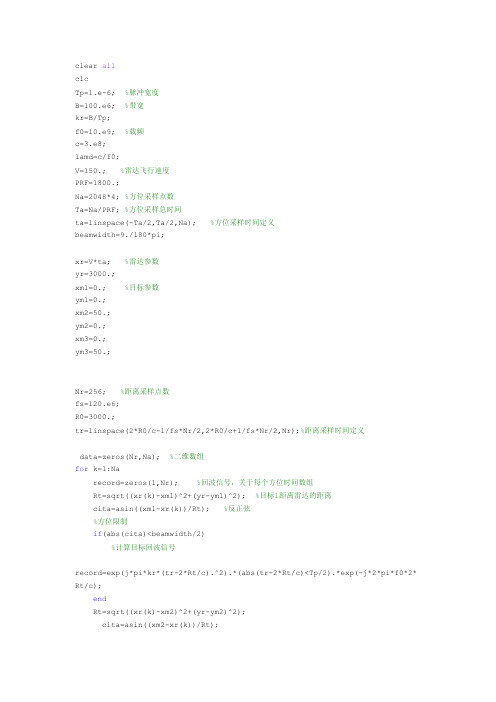
clear allclcTp=1.e-6; %脉冲宽度B=100.e6; %带宽kr=B/Tp;f0=10.e9; %载频c=3.e8;lamd=c/f0;V=150.; %雷达飞行速度PRF=1800.;Na=2048*4; %方位采样点数Ta=Na/PRF; %方位采样总时间ta=linspace(-Ta/2,Ta/2,Na); %方位采样时间定义beamwidth=9./180*pi;xr=V*ta; %雷达参数yr=3000.;xm1=0.; %目标参数ym1=0.;xm2=50.;ym2=0.;xm3=0.;ym3=50.;Nr=256; %距离采样点数fs=120.e6;R0=3000.;tr=linspace(2*R0/c-1/fs*Nr/2,2*R0/c+1/fs*Nr/2,Nr);%距离采样时间定义data=zeros(Nr,Na); %二维数组for k=1:Narecord=zeros(1,Nr); %回波信号,关于每个方位时间数组Rt=sqrt((xr(k)-xm1)^2+(yr-ym1)^2); %目标1距离雷达的距离cita=asin((xm1-xr(k))/Rt); %反正弦%方位限制if(abs(cita)<beamwidth/2)%计算目标回波信号record=exp(j*pi*kr*(tr-2*Rt/c).^2).*(abs(tr-2*Rt/c)<Tp/2).*exp(-j*2*pi*f0*2* Rt/c);endRt=sqrt((xr(k)-xm2)^2+(yr-ym2)^2);cita=asin((xm2-xr(k))/Rt);if(abs(cita)<beamwidth/2)record=record+exp(j*pi*kr*(tr-2*Rt/c).^2).*(abs(tr-2*Rt/c)<Tp/2).*exp(-j*2*p i*f0*2*Rt/c);endRt=sqrt((xr(k)-xm3)^2+(yr-ym3)^2);cita=asin((xm3-xr(k))/Rt);if(abs(cita)<beamwidth/2)record=record+exp(j*pi*kr*(tr-2*Rt/c).^2).*(abs(tr-2*Rt/c)<Tp/2).*exp(-j*2*p i*f0*2*Rt/c);enddata(:,k)=record;endfigure(1) %传统雷达图像imagesc(abs(data))title('传统雷达图像')%条带SAR成像经典算法fr=linspace(-fs/2,fs/2,Nr);%距离频率fr=fftshift(fr);hfr=exp(j*pi*fr.^2/kr);%滤波器,滤波器设计的三种算法之一,对于线性调频信号,直接根据公式计算设计hfr=transpose(hfr);%win=hamming(Nr)';%汉明窗%win=transpose(win);%hw=hfr.*win; %频域加窗,失配后的滤波器for k=1:Nadata(:,k)=ifft(fft(data(:,k)).*hfr);%data(:,k)=ifft(fft(data(:,k)).*hw); %对回波信号作fft后乘以滤波器再作逆fft endfigure(2)imagesc(abs(data(:,1:3:Na)))title('距离压缩后图像')for k=1:Nr %方位时间转化方位频率data(k,:)=fftshift(fft(data(k,:)));endfigure(3)imagesc(abs(data))title('实现方位校正后图像')fa=linspace(-PRF/2,PRF/2,Na);%方位频率det_r=lamd^2*R0/(8*V^2)*fa.^2;t0=2*det_r/c;%关于方位频率的变量for k=1:Nar_shift=exp(j*2*pi*fr*t0(k)); %计算每个频率k的距离徙动r_shift=r_shift.';%转置,向量乘法data(:,k)=ifft(fft(data(:,k)).*r_shift);endfigure(4)imagesc(abs(data))title('校正过距离徙动后的图像')R=c*tr/2; %目标距离for k=1:Nrka=-2*V^2/lamd/R(k); %对于每个目标计算线性调频参数 hfa=exp(j*pi*fa.^2/ka); %方位压缩滤波器设计data(k,:)=ifft(data(k,:).*hfa);%同距离压缩endfigure(5)imagesc(abs(data))title('方位压缩后图像')figure(6)imagesc(abs(data))plot(abs(data(128,:)))title('未加窗目标(0,0),(50,0)SAR成像')figure(7)imagesc(abs(data))plot(abs(data(88,:)))title('未加窗目标(0,50)SAR成像')% figure(8)% imagesc(abs(data))% plot(abs(data(128,:)))% title('加窗后目标(0,0),(50,0)SAR成像')% figure(9)% imagesc(abs(data))% plot(abs(data(88,:)))% title('加窗后目标(0,50)SAR成像')。
高分辨率SAR遥感综合实验与应用示范年度报告

科技资讯2016 NO.34SCIENCE & TECHNOLOGY INFORMATION 科技报告导读250科技资讯 SCIENCE & TECHNOLOGY INFORMATION高分辨率SAR 遥感综合实验与应用示范年度报告陈尔学1 田昕1 白黎娜1 赵争2 焦健3(1.中国林业科学研究院资源信息研究所;2.中国测绘科学研究院;3.北京大学)摘 要:该报告介绍了2013年度该课题在机载极化干涉SAR系统构建、高分辨率SAR遥感综合实验、高分辨率SAR遥感应用示范软件开发等方面的研发进展。
在机载极化干涉SAR系统构建方面,完成了X-波段干涉SAR传感器的研制,进行了SAR系统的实验室联调测试和机载校飞试验。
先后在四川若尔盖实验区和大兴安岭根河实验区开展了高分辨率SAR遥感综合实验,共获取8619.8km 2,约28.5TB的机载X-波段双天线InSAR和P-波段极化SAR数据,完成了所获取SAR数据的预处理;获取了覆盖大兴安岭根河实验区的多时相Radarsat-2极化SAR和Landsat-8多光谱卫星遥感数据;组织来自项目8家课题承担/协作单位的50多人次,参加了遥感同步、准同步调查工作,获取了森林叶面积指数(LAI)、农田植被参数、土壤参数、气象参数以及土地覆盖类别等的地面实况数据。
在高分辨率SAR软件开发方面,已初步完成地形测绘、土地利用分类、植被覆盖类型分类和森林植被垂直结构参数估测等软件模块原型的开发,正在按统一的语言和标准进行完善和集成,以尽快形成界面友好的高分辨率SAR应用示范软件,为2014年的应用示范工作开展提供软件支撑。
关键词:高分辨率SAR 机载SAR飞行实验 极化干涉SAR系统构建 SAR应用处理软件 SAR应用示范Annual Report for High Resolution SAR Remote SensingSynergy Experiment and Application DemonstrationChen Erxue 1 Tian Xin 1 Bai Lina 1 Zhao Zheng 2 Jiao Jian 3(1.Institute of Resource Information, Chinese Academy of Forestry; 2.China Academy of Surveying and Mapping;3.Peking University)Abstract : This report presented the annual research progress of the 863 project in 2013, in the context of construction of an airborne polarimetric interferometric SAR (PolInSAR) system, comprehensive campaign of high-resolution SAR and development of demonstration application software of high-resolution SAR, and etc.. In the aspect of airborne PolInSAR system construction, we have accomplished the construction of the X-band PolInSAR sensor, the SAR system’s laboratory joint debug test, and the aircraft flight calibration experiments. We have implemented the comprehensive experiment for high-resolution SAR in the test site of Ruoergai County of Sichuan Province and successively in the test site of Genhe of Daxing'anling in Inner Mongolia. Totally, about 28.5TB of airborne X-band double antenna InSAR and P-band polarimetric SAR data,covering 8619.8km 2 campaign area, was acquired. The preprocessing for all the SAR data has been finished. Moreover, the multi-temporal Radarsat-2 quad-polarization SAR and Landsat-8 multi-spectral satellite data covering the Genhe experi-mental area was obtained. At the meanwhile, the comprehensive and real-time or nearly real-time ground investigations were organized, and from 8 institutes and universities under the framework of the project, the teams of 50 person-times were involved. The ground truth data, such as the forest leaf area index (LAI), farmland vegetation parameters, soil and meteorological parameters and land cover types were measured. For the development of high-resolution SAR application software, the prototype of software modules has been completed, including topographic mapping, land use and vegetation type classification, forest vegetation vertical structure parameter estimation, and etc. Improvements for these modules and their integration to the whole software system are ongoing using the uniform development language and standard under the frame科技资讯2016 NO.34SCIENCE & TECHNOLOGY INFORMATION 科技报告导读251 科技资讯 SCIENCE & TECHNOLOGY INFORMATION of the project’s system software in order to develop one high resolution SAR application software with user-friendly interface.As we expected, the achievements of this year will support the application and demonstration of high resolution SAR, which is our future work in the next year 2014.Key Words : High Resolution SAR; Airborne SAR Campaign; PolInSAR System Construction; SAR Application Software; SAR Applicaiton Demostraction阅读全文链接(需实名注册):/xiangxiBG.aspx?id=65133&flag=1南极太阳系外行星搜寻与Kepler 行星TTV 研究张辉1 周济林1 付建宁2 吴江华2 周礼勇1(1.南京大学;2.北京师范大学)摘 要:南极AST3望远镜研究将会获得南天极附近天区恒星长时序高精度的测光数据。
拓展雷达应用实验报告(3篇)
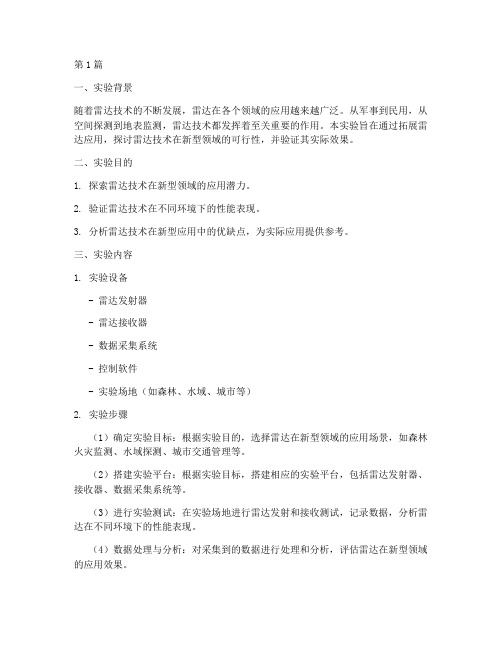
第1篇一、实验背景随着雷达技术的不断发展,雷达在各个领域的应用越来越广泛。
从军事到民用,从空间探测到地表监测,雷达技术都发挥着至关重要的作用。
本实验旨在通过拓展雷达应用,探讨雷达技术在新型领域的可行性,并验证其实际效果。
二、实验目的1. 探索雷达技术在新型领域的应用潜力。
2. 验证雷达技术在不同环境下的性能表现。
3. 分析雷达技术在新型应用中的优缺点,为实际应用提供参考。
三、实验内容1. 实验设备- 雷达发射器- 雷达接收器- 数据采集系统- 控制软件- 实验场地(如森林、水域、城市等)2. 实验步骤(1)确定实验目标:根据实验目的,选择雷达在新型领域的应用场景,如森林火灾监测、水域探测、城市交通管理等。
(2)搭建实验平台:根据实验目标,搭建相应的实验平台,包括雷达发射器、接收器、数据采集系统等。
(3)进行实验测试:在实验场地进行雷达发射和接收测试,记录数据,分析雷达在不同环境下的性能表现。
(4)数据处理与分析:对采集到的数据进行处理和分析,评估雷达在新型领域的应用效果。
3. 实验项目(1)森林火灾监测:利用雷达对森林进行监测,实时掌握森林火情,提高火灾防控能力。
(2)水域探测:利用雷达对水域进行探测,监测水质、水流速度等参数,为水资源管理提供依据。
(3)城市交通管理:利用雷达监测城市道路交通流量,为交通信号控制提供数据支持。
四、实验结果与分析1. 森林火灾监测实验结果表明,雷达在森林火灾监测中具有较高的灵敏度和准确度。
雷达可以实时监测森林火情,为火灾防控提供有力支持。
2. 水域探测实验结果显示,雷达在水域探测中表现出良好的性能。
雷达可以监测水质、水流速度等参数,为水资源管理提供可靠数据。
3. 城市交通管理实验数据表明,雷达在城市交通管理中具有较好的应用前景。
雷达可以实时监测道路交通流量,为交通信号控制提供数据支持,提高交通效率。
五、实验结论1. 雷达技术在新型领域的应用具有广阔的前景,可以为相关领域提供有力支持。
saradc课程设计
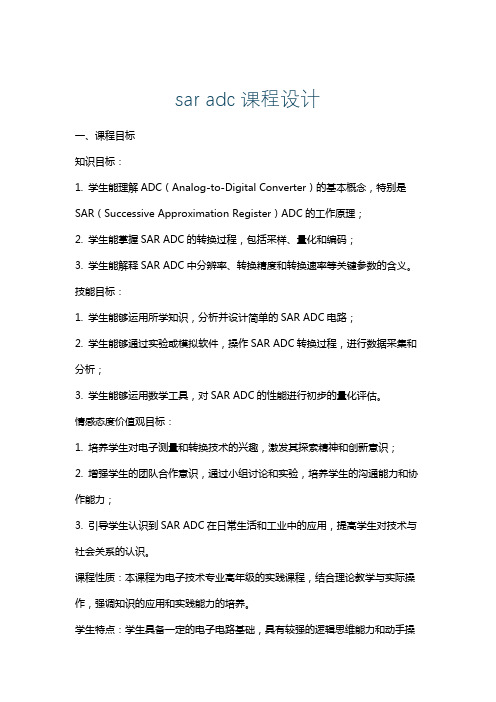
sar adc课程设计一、课程目标知识目标:1. 学生能理解ADC(Analog-to-Digital Converter)的基本概念,特别是SAR(Successive Approximation Register)ADC的工作原理;2. 学生能掌握SAR ADC的转换过程,包括采样、量化和编码;3. 学生能解释SAR ADC中分辨率、转换精度和转换速率等关键参数的含义。
技能目标:1. 学生能够运用所学知识,分析并设计简单的SAR ADC电路;2. 学生能够通过实验或模拟软件,操作SAR ADC转换过程,进行数据采集和分析;3. 学生能够运用数学工具,对SAR ADC的性能进行初步的量化评估。
情感态度价值观目标:1. 培养学生对电子测量和转换技术的兴趣,激发其探索精神和创新意识;2. 增强学生的团队合作意识,通过小组讨论和实验,培养学生的沟通能力和协作能力;3. 引导学生认识到SAR ADC在日常生活和工业中的应用,提高学生对技术与社会关系的认识。
课程性质:本课程为电子技术专业高年级的实践课程,结合理论教学与实际操作,强调知识的应用和实践能力的培养。
学生特点:学生具备一定的电子电路基础,具有较强的逻辑思维能力和动手操作能力。
教学要求:结合学生特点和课程性质,通过讲授、实验和案例分析等教学方法,使学生在掌握理论知识的基础上,提高实际操作和问题解决能力。
在教学过程中,注重分解课程目标为具体可衡量的学习成果,以便于教学设计和评估。
二、教学内容1. SAR ADC基本原理:包括ADC的概念、种类,重点讲解SAR ADC的工作流程、分辨率、转换精度等关键参数;相关教材章节:第二章“模拟-数字转换器”第3节“逐次逼近(SAR)ADC”。
2. SAR ADC电路分析与设计:分析SAR ADC的基本电路结构,讲解其内部各个部分的功能和相互关系,指导学生进行简单的电路设计;相关教材章节:第三章“SAR ADC电路分析与设计”第1、2节。
中国地质大学微波遥感上机实习报告
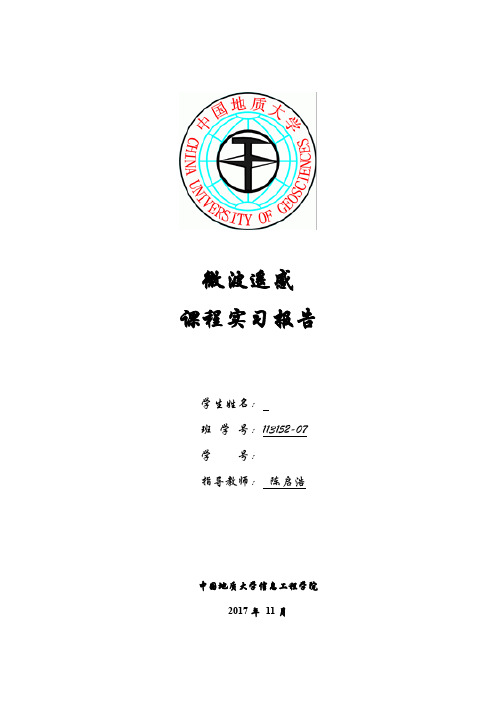
微波遥感课程实习报告学生姓名:班学号:113152-07学号:指导教师:陈启浩中国地质大学信息工程学院2017年11月目录实习一 SAR图像目视解译 .......................................................... - 2 - 【实习目的】 ........................................................................... - 2 - 【实习内容】 ........................................................................... - 2 - 【实习过程】 ........................................................................... - 2 - 实习二极化SAR信息提取 ........................................................... - 7 - 【实习目的】 ........................................................................... - 7 - 【实习内容】 ........................................................................... - 7 - 【实习过程】 ........................................................................... - 7 - 心得与体会 ................................................................................... - 10 -实习一 SAR图像目视解译【实习目的】1.熟悉常用的SAR图像分析软件,2.了解SAR图像格式和元数据信息,3.利用所学的SAR图像特性进行目视解译。
微波遥感实验报告(李翔)

xxx学院微波遥感实验报告专业:xx班级:xx班姓名:xx学号:xx实验名称:AMSER-E、SAR数据数据认识实验教室:xx教室指导老师:xxx1. 实验目的:认识了解常用的微波遥感数据,如AMSER-E数据、SAR数据等,能够使用Surfer等软件查看数据基本参数等。
2. AMSER-E数据认识2.1 介绍搭载于EOS-Aqua上的高级微波扫描辐射计(AMSR-E)是一种被动式微波遥感仪。
AMSR-E 于2002年由Aqua搭载升空,入射角为55°,刈宽为1445km,其频率为6.9GHz,10.7GHz,18.7GHz,23.8GHz,36.5GHz和89GHz,每个频率均有V和H两个通道。
AMSR为日本前宇宙开发事业集团(NASDA)研制的传感器,使用尺寸为2cm的抛物面天线,圆锥扫描,空间分辨率为从6.9GHz的60km左右到89GHz的5km左右,经改进后搭载于EOS的Aqua上升空,称为AMSR-E。
Aqua是包含在EOS观测平台上的其中一颗多功能观测卫星,它是太阳同步观测下午星,因此AMSR-E的赤道过境时间为下午1:30(降轨)和凌晨1:30(升轨)。
2.2升降双极化数据比较使用Surfer软件画图:升轨数据6.9GHz垂直极化6.9GHz水平极化降轨数据6.9GHz垂直极化6.9GHz水平极化3. SAR数据认识目前用的比较多的SAR数据有:10-20m分辨率的ALOS-PALSAR,3m精细分辨率的RADARSAT2/SAR,3m分辨率的COSMO/SAR。
最高分辨率的是2007年发射的TERRA SAR-X,分辨率为1m。
特点:1、斜距图像,分辨率不一致。
2、斜距图像上近距离被压缩。
3、出现透视收缩、叠掩和阴影现象。
4、高程影响特别明显。
位移指令实验报告

一、实验目的1. 理解位移指令的基本概念和作用。
2. 掌握位移指令的使用方法和操作步骤。
3. 通过实验验证位移指令在实际编程中的应用效果。
二、实验环境1. 操作系统:Windows 102. 编译器:Keil uVision53. 微控制器:STC89C52三、实验原理位移指令(Shift Instruction)是计算机汇编语言中的一种基本指令,用于对寄存器或内存单元中的数据进行移位操作。
根据移位方向,位移指令可以分为逻辑移位和算术移位两种。
逻辑移位指令用于无符号数,而算术移位指令用于有符号数。
逻辑移位指令包括:SHL(逻辑左移)、SHR(逻辑右移)、SAL(算术左移)、SAR (算术右移)。
循环移位指令包括:ROL(带进位的左循环移位)、ROR(带进位的右循环移位)、RCL(带进位的左循环移位)、RCR(带进位的右循环移位)。
四、实验内容1. 实验一:位移指令的基本操作(1)编写程序,实现将寄存器A中的数据左移1位。
(2)编写程序,实现将寄存器B中的数据右移1位。
(3)编写程序,实现将数据存储单元[30H]中的数据左移2位。
2. 实验二:位移指令的应用(1)编写程序,实现将数据存储单元[30H]中的数据右移3位,并将结果存储到寄存器C中。
(2)编写程序,实现将数据存储单元[40H]中的数据左移4位,并将结果存储到寄存器D中。
(3)编写程序,实现将寄存器E中的数据循环右移5位,并将结果存储到数据存储单元[50H]中。
五、实验步骤1. 打开Keil uVision5,创建一个新的项目。
2. 在项目中添加一个新的C文件,命名为“位移指令实验.c”。
3. 编写实验一和实验二中的程序代码。
4. 下载程序到STC89C52微控制器。
5. 运行程序,观察实验结果。
六、实验结果与分析1. 实验一结果分析(1)将寄存器A中的数据左移1位后,结果应与原数据左移1位后的结果相同。
(2)将寄存器B中的数据右移1位后,结果应与原数据右移1位后的结果相同。
关于雷达的实验报告

一、实验目的1. 了解雷达系统的工作原理和基本组成;2. 掌握雷达系统参数的测量方法;3. 分析雷达系统的性能指标;4. 熟悉雷达系统的调试与优化。
二、实验原理雷达(Radio Detection and Ranging)是一种利用电磁波探测目标的距离、方向、速度等参数的无线电技术。
雷达系统主要由发射机、接收机、天线、信号处理单元等组成。
1. 发射机:产生连续波或脉冲波,向目标发射;2. 接收机:接收目标反射回来的电磁波;3. 天线:发射和接收电磁波;4. 信号处理单元:对接收到的信号进行处理,得到目标参数。
三、实验内容1. 雷达系统组成与工作原理;2. 雷达系统参数测量;3. 雷达系统性能指标分析;4. 雷达系统调试与优化。
四、实验步骤1. 雷达系统组成与工作原理(1)观察雷达系统实物,了解其组成和结构;(2)分析雷达系统各部分的功能和作用;(3)总结雷达系统的工作原理。
2. 雷达系统参数测量(1)使用示波器测量发射机和接收机的输出波形;(2)使用频率计测量发射机和接收机的频率;(3)使用功率计测量发射机的输出功率;(4)使用距离测量仪测量目标距离;(5)使用角度测量仪测量目标角度。
3. 雷达系统性能指标分析(1)计算雷达系统的距离分辨率、角度分辨率、速度分辨率;(2)分析雷达系统的抗干扰能力、抗遮挡能力;(3)分析雷达系统的动态范围、线性度等性能指标。
4. 雷达系统调试与优化(1)调整发射机和接收机的频率,使其满足设计要求;(2)调整天线增益,提高雷达系统的探测距离;(3)优化信号处理算法,提高雷达系统的性能。
五、实验结果与分析1. 雷达系统组成与工作原理通过观察雷达系统实物和理论分析,掌握了雷达系统的组成和结构,了解了雷达系统的工作原理。
2. 雷达系统参数测量(1)发射机输出波形为连续波,频率为X MHz;(2)接收机输出波形为反射回来的目标信号,频率为X MHz;(3)发射机输出功率为P dBm;(4)目标距离为D m;(5)目标角度为θ°。
INSAR实验报告

实验一、SAR信号统计模型验证实验目的通过MATLAB®程,拟合有关SAR数据的实部、虚部、灰度、相位的概率密度曲线,并与实际曲线进行比较,掌握MATLAB®程的初步知识。
实验数据txt文本格式的实部和虚部数据实验步骤一、打开MATLAB根据老师给出的实部的MATLA的程序和拟合曲线,试着编出虚部的程序,调试并运行。
二、在实部实验的基础上,接着进行以后的改编,根据各个曲线的表达式,拟合各自的曲线。
实验结果实部:54-53-4-3_.5He alistiic component(Re)2000灰度: 相位: ■F nt®rr实验心得这是首次用MATLABS 程实现SAR 的统计特征图像,由于之前没有用MATLA 编程 实现过,所以这次实验是在学习老师所给程序的基础上进行改编的。
学会了 MATLAB 中画图函数的编写,函数曲线的颜色、线型、多幅图像同时呈现编程方 法。
但是功率power 的图像画的并不理想,拟合的曲线并没有很好地显示出来。
通过这次的练习,平时老师课件里的东西,我们也能编程写出来,确实让我们学 会了理论联系实践,学以致用。
这次的实验还比较顺利,希望在以后的学习和实 验中可以更多的学习一些软件,多用编程的思想实现一些自己的想法。
实验源代码实部:clear; clc; load “; load “;[m,n]= size(Real);Realvector=reshape(Real,m* n,1); maxrea 匸max(Realvector); min real=min( Realvector); x=min real:10:maxreal; Realvar=var(Realvector);3 5 2 5 2..ru r l a s -d0.5°O1 .52 2.5Power(P)□ .S*PDF_Re=exp(-x.A2/(2*Realvar))/sqrt(2*pi*Realvar); pixel_count1=PDF_Re*10*m*n;figure;plot(x,pixel_count1, 'r' ); count2=hist(Realvector,x);hold on;plot(x,count2, 'rs' , 'MarkerEdgeColor' ,'k' 'MarkerFaceColor' , 'g' , ...'MarkerSize' ,2);ylabel( 'Pixel count' );xlabel( 'Realistic component(Re)' );虚部:clear;clc;load '' ;load '' ;[m,n] = size(Imag);Imagvector=reshape(Imag,m*n,1); maximag=max(Imagvector); minimag=min(Imagvector);x=minimag:10:maximag;Imagvar=var(Imagvector);PDF_lm=exp(-x.A2/(2*lmagvar))/sqrt(2*pi*lmagvar); pixel_count2=PDF_Im*10*m*n;figure;plot(x,pixel_count2, 'r' ); count=hist(lmagvector,x);hold on;plot(x,count, 'rs' , 'MarkerEdgeColor' , 'k' , 'MarkerFaceColor' , 'g' , ...'MarkerSize' ,2);ylabel( 'Pixel count' );xlabel( 'lmaginary component(lm)' );灰度:load '' ;load '' ;[m,n] = size(lmag);Amplitude=sqrt(Real.A2+Imag.A2); Amplitudevector=reshape(Amplitude,m*n,1);Ampvar=var(Amplitudevector)*2/(4-pi); maxAmp=max(Amplitudevector); minAmp=min(Amplitudevector); X=minAmp:10:maxAmp;PDF_A=X.*exp(-X.A2/(2*Ampvar))/Ampvar;pixel_count2=PDF_A*10*m*n; figure;plot(X,pixel_count2, 'r' ); count=hist(Amplitudevector,X); hold on;plot(X,count, 'rs' , 'MarkerEdgeColor' 'MarkerFaceColor' , 'g' 'MarkerSize' ,2); ylabel( 'Pixel count' );xlabel( 'Amplitude component(A)' );功率:clear; clc; load '' ; load '' ;Powe=Real.A2+lmag.A2; [m,n] = size(Powe);Powevector=reshape(Powe,m*n,1); maxPowe=max(Powevector); minPowe=min(Powevector); x=minPowe:10000:maxPowe; Powevar=var(Powevector);PDF_P=(exp(-x/(2*Powevar)))/(2*Powevar); pixel_count4=PDF_P*10*m*n; figure;plot(x,pixel_count4, 'y' ); count=hist(Powevector,x); hold on;plot(x,count, 'rs' , 'MarkerEdgeColor''MarkerFaceColor' , 'g' 'MarkerSize' ,2);ylabel( 'Pixel count' ); xlabel( 'Power(P)' );相位:clear; clc; load '' ; load '' ;[m,n] = size(lmag);lmagvector=reshape(lmag,m*n,1); Realvector=reshape(Real,m*n,1); Phase=atan2(lmagvector,Realvector); x=-pi:pi/100:pi; PDF_w=1/(2*pi);pixel_count2=PDF_w*pi/100*m*n; figure;plot(x,pixel_count2, 'r' ); count=hist(Phase,x); hold on;, 'k', 'k'plot(x,count, 'rs' , 'MarkerEdgeColor' , 'k' , ...'MarkerFaceColor' , 'g' , ...'MarkerSize' ,2);ylabel( 'Pixel count' );xlabel( 'Phase component(Ph)' );实验二INSAR信号统计模型验证实验目的通过MATLA ffi程实现INSAR勺数据统计特征的表达,掌握用MATLA编写函数的方法,进一步掌握MATLA在INSAR K验中的应用。
微波遥感实习报告材料
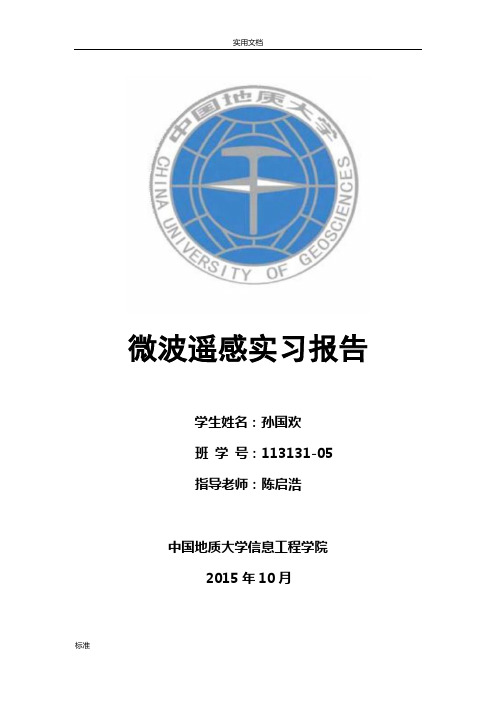
微波遥感实习报告学生姓名:孙国欢班学号:113131-05指导老师:陈启浩中国地质大学信息工程学院2015年10月一、SAR图像目视解译实验目的:熟悉常用SAR图像分析软件,了解SAR图像格式和元数据信息,利用所学的SAR图像特性进行目视解译。
参考软件:ENVI SARscape, ERDAS, Nest, Best, GAMMA等。
实验内容:1. 选用1景或多景SAR图像,利用不同软件查看其数据和元数据信息,并列出数据大小、范围、分辨率、轨道参数、极化方式等信息;2. 选取1景或多景SAR图像进行目视解译,分析图像范围内地物的目视解译结果,并给出解译依据;3. 掌握斜距转地距、多视处理、滤波处理等基本功能,并对处理后结果进行分析;4. 对软件的其它功能操作内容,可自行添加。
要求说明:1. 结合上课内容,合理、全面运用所学知识进行目视解译;2. Nest必需使用,ENVI/ERDAS可二选一;3. 鼓励自己下载SAR图像数据进行分析处理。
实习过程:要利用不同软件查看1景或多景SAR图像数据和元数据信息,并列出数据大小、范围、分辨率、轨道参数、极化方式等信息。
我采用了四个软件进行完成,分别是Nest、Best、ERDAS和ENVI。
读取SAR图像文件的头文件信息可以看到其相关参数,我最后都以text文件形式导出。
(1) 我使用的SAR图像文件是微波遥感\数据备份\ASAR_wuhan 里的ASA_IMP_1PNPDE20090125_141620_000000152075_00483_36108_5832.N1 1、Nest软件使用打开File下方的添加文件后打开文件,在Metadata里可以看到它的文件类型、相关参数。
包括文件类型、文件日期、轨迹和轨道。
影像类型:ENVISAT获取模式:Stripmap处理软件版本:ASAR/4.07获取时间:2009-1-25 14:17:00升降轨:ASCENDING采样类型:DETECTED极化方式:VV2、ERDAS 软件使用打开erdas 里的图标功能使其展示文件参数,结果如下。
学生参加社会实践的活动总结(2篇)
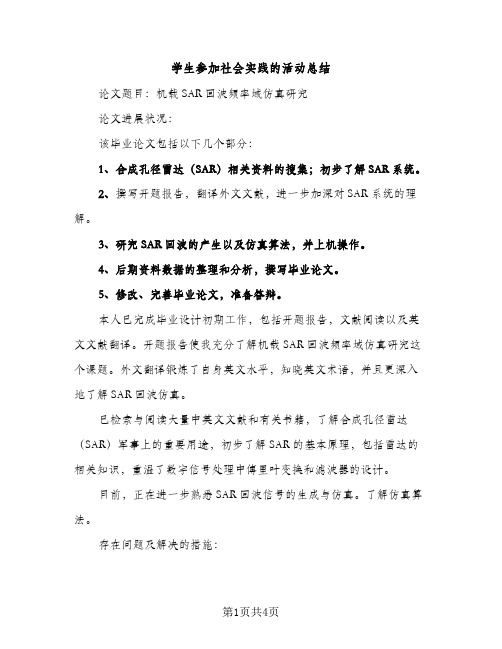
学生参加社会实践的活动总结论文题目:机载SAR回波频率域仿真研究论文进展状况:该毕业论文包括以下几个部分:1、合成孔径雷达(SAR)相关资料的搜集;初步了解SAR系统。
2、撰写开题报告,翻译外文文献,进一步加深对SAR系统的理解。
3、研究SAR回波的产生以及仿真算法,并上机操作。
4、后期资料数据的整理和分析,撰写毕业论文。
5、修改、完善毕业论文,准备答辩。
本人已完成毕业设计初期工作,包括开题报告,文献阅读以及英文文献翻译。
开题报告使我充分了解机载SAR回波频率域仿真研究这个课题。
外文翻译锻炼了自身英文水平,知晓英文术语,并且更深入地了解SAR回波仿真。
已检索与阅读大量中英文文献和有关书籍,了解合成孔径雷达(SAR)军事上的重要用途,初步了解SAR的基本原理,包括雷达的相关知识,重温了数字信号处理中傅里叶变换和滤波器的设计。
目前,正在进一步熟悉SAR回波信号的生成与仿真。
了解仿真算法。
存在问题及解决的措施:在前期研究过程中,某些知识不过关,一些基本问题无法得到解决,经过查阅有关教科书和请教老师,这个问题逐渐得到缓解;在撰写论文开题报告时,参考文献的格式书写有误,后期校验出现不少纰漏,认真参照相关规定,最后将其改正。
在外文翻译初稿中,出现语病,专业词汇翻译不准确、格式书写有误等问题,经过审阅多遍完成了该任务。
学生参加社会实践的活动总结(二)社会实践是学生在校园之外,亲身参与社会活动的一种方式。
通过参与社会实践,学生能够更好地了解社会现象和问题,增长社会经验和实践能力,拓宽自己的眼界,培养社会责任感和公民意识。
在我参加的社会实践活动中,我深切感受到了社会的多样性和复杂性,也收获了许多宝贵的经验和教训。
我参加的社会实践活动是到一所乡村小学当志愿者教师,为贫困地区的孩子们提供教育和关爱。
在这个活动中,我主要负责教授语文和数学两门课程。
起初,我对于教学工作感到有些茫然和无措,因为我没有实际的教学经验。
然而,随着时间的推移,我逐渐适应了教学环境,并且提高了我的教学能力。
雷达技术实验报告

雷达技术实验报告雷达技术实验报告专业班级:姓名:学号: ﻩ一、实验内容及步骤1、产生仿真发射信号:雷达发射调频脉冲信号,IQ两路;2、观察信号得波形,及在时域与频域得包络、相位;3、产生回波数据:设目标距离为R=0、5000m;4、建立匹配滤波器,对回波进行匹配滤波;5、分析滤波之后得结果。
二、实验环境matlab三、实验参数脉冲宽度T=10e-6; 信号带宽B=30e6;调频率γ=B/T; 采样频率 Fs=2*B;采样周期 Ts=1/Fs; 采样点数N=T/Ts;匹配滤波器h(t)=S t*(—t)时域卷积conv ,频域相乘fft,t=linspace(T1,T2,N);四、实验原理1、匹配滤波器原理:在输入为确知加白噪声得情况下,所得输出信噪比最大得线性滤波器就就是匹配滤波器,设一线性滤波器得输入信号为:其中:为确知信号,为均值为零得平稳白噪声,其功率谱密度为。
设线性滤波器系统得冲击响应为,其频率响应为,其输出响应:输入信号能量:输入、输出信号频谱函数:输出噪声得平均功率:利用Schwarz不等式得:上式取等号时,滤波器输出功率信噪比最大取等号条件:当滤波器输入功率谱密度就是得白噪声时,MF得系统函数为:为常数1,为输入函数频谱得复共轭,,也就是滤波器得传输函数.为输入信号得能量,白噪声得功率谱为只输入信号得能量与白噪声功率谱密度有关。
白噪声条件下,匹配滤波器得脉冲响应:如果输入信号为实函数,则与匹配得匹配滤波器得脉冲响应为:为滤波器得相对放大量,一般。
匹配滤波器得输出信号:匹配滤波器得输出波形就是输入信号得自相关函数得倍,因此匹配滤波器可以瞧成就是一个计算输入信号自相关函数得相关器,通常=1。
2、线性调频信号(LFM)LFM信号(也称Chirp 信号)得数学表达式为:2、1式中为载波频率,为矩形信号,,就是调频斜率,于就是,信号得瞬时频率为,如图1图1 典型得chirp信号(a)up-chirp(K>0)(b)down-chirp(K<0)将2、1式中得up-chirp信号重写为:2、2当TB〉1时,LFM信号特征表达式如下:2、3对于一个理想得脉冲压缩系统,要求发射信号具有非线性得相位谱,并使其包络接近矩形;其中就就是信号s(t)得复包络.由傅立叶变换性质,S(t)与s(t)具有相同得幅频特性,只就是中心频率不同而已。
图像变化检测实例及源代码

智能计算导论课程实验报告2011年6月27日智能计算导论课程实验报告1实验结果1.1Berma图1-1 SAR图像1(1999.4)图1-2 SAR图像2(1999.2)图1-3 变化检测结果图1-4 变化检测结果错误像素分布(包括漏检像素和错检像素)表格1-1 变化检测结果统计1.2墨西哥市郊图1-5 SAR图像1(2002.5)图1-6 SAR图像2(2005.4)图1-7 变化检测结果图1-8 变化检测结果错误像素分布(包括漏检像素和错检像素)表格1-2 变化检测结果统计2结果分析1.由错误像素分布图,我们可以看出,大部分错误像素点集中在变化区域的边缘,这主要与聚类的算法有关,改进聚类算法可以进一步减少错误像素点的个数。
另外,也可以改变领域位置指示集的形状,进而提升模糊差异图的精确度。
2.针对不同的图像,对双边滤波器使用不同的参数,才能达到最好的效果。
3算法流程图图3-1 算法流程图4参考文献1.Image Change Detection Algorithms: A Systematic Survey, Richard J. Radke, Member, IEEE,Srinivas Andra, Student Member, IEEE, Omar Al-Kofahi, and Badrinath Roysam, Member, IEEE, Student Member, IEEE2.SAR变化检测技术发展综述, 陈富龙,张红,王超5程序代码clear allclose allclcI1=imread('2002.5.bmp');I2=imread('2005.4.bmp'); I1=rgb2gray(I1);I2=rgb2gray(I2);I1=im2double(I1);I2=im2double(I2);%D=I2-I1;%imshow(D,[])%%[m,n]=size(I1);DI=zeros(m,n);for ii=1:mfor jj=1:nDI1=0;DI2=0;if ii>1&&jj>1&&ii<m&&jj<nfor iii=ii-1:ii+1for jjj=jj-1:jj+1DI1=DI1+min(I1(iii,jjj),I2(iii,j jj));DI2=DI2+max(I1(iii,jjj),I2(iii,j jj));endendelseif ii==1&&jj~=1&&jj~=nfor iii=ii:ii+1for jjj=jj-1:jj+1DI1=DI1+min(I1(iii,jjj),I2(iii,j jj));DI2=DI2+max(I1(iii,jjj),I2(iii,j jj));endendelseif ii==m&&jj~=1&&jj~=nfor iii=ii-1:iifor jjj=jj-1:jj+1DI1=DI1+min(I1(iii,jjj),I2(iii,j jj));DI2=DI2+max(I1(iii,jjj),I2(iii,j jj));endendelseif jj==1&&ii~=1&&ii~=mfor iii=ii-1:ii+1for jjj=jj:jj+1DI1=DI1+min(I1(iii,jjj),I2(iii,j jj));DI2=DI2+max(I1(iii,jjj),I2(iii,j jj));endendelseif jj==n&&ii~=1&&ii~=mfor iii=ii-1:ii+1for jjj=jj-1:jjDI1=DI1+min(I1(iii,jjj),I2(iii,j jj));DI2=DI2+max(I1(iii,jjj),I2(iii,j jj));endendelseif ii==1&&jj==1for iii=ii:ii+1for jjj=jj:jj+1DI1=DI1+min(I1(iii,jjj),I2(iii,j jj));DI2=DI2+max(I1(iii,jjj),I2(iii,j jj));endendelseif ii==1&&jj==nfor iii=ii:ii+1for jjj=jj-1:jjDI1=DI1+min(I1(iii,jjj),I2(iii,j jj));DI2=DI2+max(I1(iii,jjj),I2(iii,j jj));endendelseif ii==m&&jj==1for iii=ii-1:iifor jjj=jj:jj+1DI1=DI1+min(I1(iii,jjj),I2(iii,j jj));DI2=DI2+max(I1(iii,jjj),I2(iii,j jj));endendelseif ii==m&&jj==nfor iii=ii-1:iifor jjj=jj-1:jj DI1=DI1+min(I1(iii,jjj),I2(iii,j jj));DI2=DI2+max(I1(iii,jjj),I2(iii,j jj));endendendDI(ii,jj)=DI1/DI2;endendfigure,imshow(DI,[])%% bilateral filter%DI=bilateralfilter(DI, [m n], 8, 0.6);DI=fastbilateral(uint8(DI),25,0. 4);figure,imshow(DI,[])%% fcmIM=DI;IMM=cat(3,IM,IM);cc1=8;cc2=200;ttFcm=0;while(ttFcm<15)ttFcm=ttFcm+1;c1=repmat(cc1,m,n);c2=repmat(cc2,m,n);c=cat(3,c1,c2);ree=repmat(0.000001,m,n);ree1=cat(3,ree,ree);distance=IMM-c;distance=distance.*distance+ree1 ;daoShu=1./distance;daoShu2=daoShu(:,:,1)+daoShu(:,: ,2);distance1=distance(:,:,1).*daoSh u2;u1=1./distance1;distance2=distance(:,:,2).*daoSh u2;u2=1./distance2;ccc1=sum(u1.*u1.*IM)/sum(u1.*u1) ;ccc2=sum(u2.*u2.*IM)/sum(u2.*u2) ;tmpMatrix=[abs(cc1-ccc1)/cc1,abs (cc2-ccc2)/cc2];pp=cat(3,u1,u2);for i=1:mfor j=1:nifmax(pp(i,j,:))==u1(i,j)IX2(i,j)=1;elseifmax(pp(i,j,:))==u2(i,j)IX2(i,j)=2;endendend%ÅнáÊøÌõ¼þif max(tmpMatrix)<0.0001break;elsecc1=ccc1;cc2=ccc2;endfor i=1:mfor j=1:nif IX2(i,j)==2IMMM(i,j)=255;elseif IX2(i,j)==1IMMM(i,j)=0;endendendendfor i=1:mfor j=1:nif IX2(i,j)==2IMMM(i,j)=255;elseif IX2(i,j)==1IMMM(i,j)=0;endendend%ÏÔʾ×îÖÕ·ÖÀà½á¹ûfigure,imshow(IMMM,[]);imwrite(IMMM,'mask.bmp')%figure,imshow('reference.bmp'); %end%%mask=imread('mask.bmp');mask1=im2bw(mask,0.5);sum(sum(mask1))ref=imread('reference.jpg');ref1=im2bw(ref,0.5);sum(sum(ref1))error=xor(mask1,ref1);figure,imshow(error,[])figure,imshow(and(mask1,ref1),[] )FP=0;FN=0;for i=1:mfor j=1:nifmask1(i,j)==1&&ref1(i,j)==0FP=FP+1;endifmask1(i,j)==0&&ref1(i,j)==1FN=FN+1;endendendFPFNsum(sum(and(mask1,ref1)))。
- 1、下载文档前请自行甄别文档内容的完整性,平台不提供额外的编辑、内容补充、找答案等附加服务。
- 2、"仅部分预览"的文档,不可在线预览部分如存在完整性等问题,可反馈申请退款(可完整预览的文档不适用该条件!)。
- 3、如文档侵犯您的权益,请联系客服反馈,我们会尽快为您处理(人工客服工作时间:9:00-18:30)。
SAR Imaging Based On the Range DopplerAlgorithmIntroductionAfter the course Radar Imaging, I did a simulation experiment in which I try to use Range Doppler Algorithm (RDA) for SAR Imaging. Here is my report for the experiment.In my simulation experiment, I got an ideal result of 3 point targets imaging based on the RDA on the condition of high squint.First of all, I would like to give the parameters used in my simulation.Then it is the flow chart of the algorithm.Raw radar dataResult Output Result analysis1.The echo signal2 (,)rect expexpcs t j kTjττπτ⎛-⎧⎫⎪⎪⎛=⋅-⎨⎬⎝⎪⎪⎪⎩⎭⎝⎭⎧⋅-⎨⎩This is the echo dataThis is the real part of the echo data2.Range compression and the SRCTo do range compression we can simply add a matched filter2()exp{}r rc r rj f H f K π=While the SRC filter is 2()exp{}r src r srcj f H f K π-=These two filters can be combined as one filter:2()exp{}r m r mj f H f K π=Where 1/rm r srcK K K K =-This is the signal after rangecompression and SRC.3. Range Cell Migration Correction (RCMC)The migration factor (,)a r D f V =()H j ω()()i i s t n t +()()o o s t n t +()h tThe phase multiplier 44exp{}exp{}(,)r c r crcmc a r j f R f o G D f V c cππ-=⋅Where c ois the range of the scene center.This is the signal after RCMC.4. Azimuth CompressionAfter RCMC, a matched filter is applied to focus the data in the azimuth direction.004(,)exp{}a r fa j R D f V f H cπ=The result is as follow:Data after azimuth compression.This is the required result. ConclusionAfter doing this simulation, I learned more on SAR imaging. It ’s the practical knowledge. I understood how to achieve the algorithm with IDL instead of just understanding it on the book. But I realize that no matterthe algorithm or the understanding of SAR, on which my study is still primary. I’m looking forward to access more and go deeper in this field.CODE;====矩形窗函数==================================function rect,tsizearr=size(t)ff=fltarr(sizearr(1))index=where(abs(t) le 0.5)ff(index)=1.return,ffend;;==========雷达参数================c=double(3.e8) ;光速lamd=double(0.03) ;波长fc=double(c/lamd) ;载频Br=double(1.e8) ;发射信号带宽Kr=double(1.5e13) ;距离调频率Tu=double(Br/Kr) ;发射脉冲时宽fs=double(Br*1.5) ;距离采样率PRF=double(300.0)Vr=double(100.0)Na=1024Nr=2048R0=double(2.e4)cita=double(20.*!pi/180) ;波束斜视角(radian)ta=(dindgen(Na)-Na/2)/PRF ;慢时间;=====================目标位置参数======================== xx=0yy=0x1=30y1=0;=====================雷达位置参数======================== x=vr*ta-R0*sin(cita) ;雷达方位位置y=R0*cos(cita) ;雷达距离位置dt=double(sqrt(x^2+y^2))Rref=dt ;参考目标实时距离oc=Rref[Na/2] ;场景中心距离;;================== 回波模拟======================= tr=(dindgen(Nr)-Nr/2)/fs+2*oc/crecord=dcomplexarr(Nr) ;一个脉冲记录data=dcomplexarr(Na,Nr) ;回波二维数组for ii=0LL,Na-1LL do beginrecord=dcomplexarr(Nr)Rt=sqrt((x(ii)-xx)^2+(y-yy)^2) ;目标到雷达瞬时距离Rt1=sqrt((x(ii)-x1)^2+(y-y1)^2)record0=rect((tr-2.*Rt/c)/Tu)*exp(dcomplex(0,!pi*kr*(tr-2.*Rt/c)^2))*exp(dcomplex(0,-4.*!pi/la md*Rt))record1=rect((tr-2.*Rt1/c)/Tu)*exp(dcomplex(0,!pi*kr*(tr-2.*Rt1/c)^2))*exp(dcomplex(0,-4.*!pi/ lamd*Rt1))data(ii,*)=record0+record1endforwindow,0contour,abs(data)window,10contour,real_part(shift(fft(data),Na/2,Nr/2));write_tiff,'d:\im3.tif',bytscl(abs(real_part(data)));write_tiff,'d:\im4.tif',bytscl(real_part(data));stop;===================== RD算法========================Fac=double(2*Vr*sin(cita)/lamd)Rc=dt[na/2]*cos(cita)fr=shift((dindgen(Nr)-Nr/2)*Fs/Nr,0/2);fa=shift((dindgen(Na)-Na/2)*PRF/Na,0/2)+Fac;D=sqrt(1-lamd^2*fa^2/4./Vr^2)Ksrc=2.*Vr^2*Fc^3*D^3/c/Rc/Fa^2;Hfr=exp(dcomplex(0,!pi*Fr^2/Kr));距离向匹配滤波器Hsrc=dcomplexarr(Na,Nr);for i=0,Na-1 do beginHsrc[i,*]=exp(dcomplex(0,-1*!pi*Fr^2/Ksrc[i]));endfor ;SRC滤波器for j=0,Nr-1 do begindata[*,j]=data[*,j]*exp(dcomplex(0,-2*!pi*Fac*ta));endfordata=shift(fft(data),Na/2,Nr/2);;=================距离压缩与二次距离压缩=============for i=0,Na-1 do begindata(i,*)=data(i,*)*exp(dcomplex(0,!pi*Fr^2/Kr))*Hsrc[i,*]endforwindow,1contour,abs(fft(data,1));;============距离徙动校正=============for i=0,Na-1 do beginrcmc=exp(dcomplex(0,4*!pi*Fr*Rc/d[i]/c))*exp(dcomplex(0,-4*!pi*Fr*oc/c)) ;dt[Na/2]-->o cdata[i,*]=fft(data[i,*]*rcmc,1)endforwindow,2contour,abs(data);;=================方位向压缩=============rt1=double(oc*cos(cita)+(i-Nr/2)*c/2./Fs);for i=0,Nr-1 do beginh_fa=exp(dcomplex(0,4*!pi*rt1*fc/c*D))*exp(dcomplex(0,-2*!pi*fa*oc*sin(cita)/Vr))data(*,i)=fft(data(*,i)*h_fa,1)endforwindow,3contour,abs(data)end。
